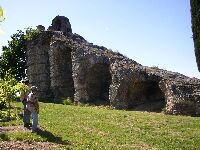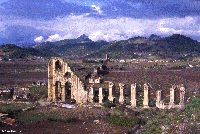Longest siphons in Roman aqueducts
One way by which natural features such as valleys and depressions could be crossed, was the (inverted) siphon, a technique based on the simple physical principle that 'water finds its own level'. The Romans and even the Greek were well aware of this principle. The basic purpose was to prevent long detours.Based on own estimate 10% of all Roman aqueducts were equipped with one or more siphons. In the aqueduct literature the nine siphons in the four aqueducts of Roman Lyon (France) are often cited. As far as we know there were even two instances with double siphons among which the Capronne siphon in the Yzeron aqueduct supplying Lyon. The other was in Aspendos (Turkey).
Vitruvius - a Roman architect from the 1 c BC who left a treatise called 'de architectura' - made reference to a venter (the lowest part of the siphon) and geniculus (vertical bends), but he also introduced the term 'colliviaria' a term which has caused much discussion. One of the functions of this device could have been to let air-bubbles escape from the aqueduct pipes. Some aqueducts were indeed equipped with this type of device. Later instances were found in Turkish siphons, called suterazi (water balance).
| Name aqueduct | Length (m) | Literature | Remarks |
|---|---|---|---|
| Smyrna (Turkey) | 4.400 | Kessener 2001, 2004 | |
| Lyon, Yzeron (France) | 3.600 | Burdy 1991, Kessener 2001,2004 | Craponne II |
| Lyon, Brevenne (France) | 3.500 | Burdy 1993, Kessener 2001,2004 | Ecully (Grange-Blanche) |
| Lyon, Mont d'Or (France) | 3.500 | Burdy 1987, Kessener 2001,2004 | des Planches (Ecully) |
| Pergamon, Madradag (Turkey) | 3.250 | Kessener 2001,2004 | |
| Alatri (Italy) | 3.000 | Kessener 2001,2004 | |
| Lyon, Gier (France) | 2.600 | Burdy 1996, Kessener 2001,2004 | Yzeron (Beaunant) |
| Lyon, Yzeron (France) | 2.200 | Burdy 1996, Kessener 2001,2004 | Craponne I (Grezieux) |
| Aspendos (Turkey) | 1.670 | Kessener 2001,2004 | total length |
| Termini Imerese, Barratina (Italy) | 1.300 | Kessener 2001,2004 | |
| Lyon, Gier (France) | 1.210 | Burdy 1996, Kessener 2001,2004 | Garon (Soucieu) |
| Laodikeia ad Lykum (Turkey) | 800 | Kessener 2001,2004 | |
| Lyon, Gier (France) | 700 | Burdy 1996, Kessener 2001,2004 | Dureze (St. Genis) |
| Oinoanda (Turkey) | 600 | Stenton 1996, Kessener 2001,2004 | |
| Lyon, Gier (France) | 575 | Kessener 2001,2004 | Trion (St. Irenee) |
| Lyon, Brevenne (France) | 500 | Burdy 1993 | hypothetically |
| Lyon, Mont d'Or (France) | 420 | Burdy 1987, Kessener 2001,2004 | Limonest (Cotte-Chally) |
| Patara (Turkey) | 260 | Kessener 2001,2004 | Delik Kemer |
| HOME | Literature references | Last modified: January, 2012 by w.d.schram 'at' romanaqueducts.info |


